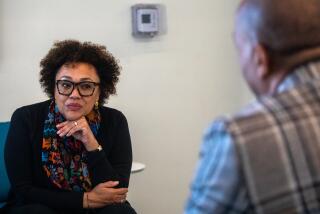NEA CALLS FOR ‘BOLD STEPS’ IN ART EDUCATION
- Share via
SEATTLE — Frank Hodsoll, chairman of the National Endowment for the Arts, is stirring up a hornet’s nest here with a seemingly simple proposal. He wants to make certain that the American high school graduate is literate in the arts.
Citing blue-chip support from such bodies as the Rockefeller Foundation and the Getty Trust, Hodsoll is talking about national objectives to give students “not only general knowledge in basic skills but also some measure of critical judgment or taste” in all of the arts. However, artist-in-education coordinators, gathered here from across the country, fear that Hodsoll’s objectives would move the endowment away from current artist-in-residency programs. The endowment contributes to these state-run programs on a 4 1/2-to-1 matching basis, but a change in national direction could influence state policies.
Speaking on the opening day at the 11th annual National Assembly of State Arts Agencies Convention on Thursday, Hodsoll called for “bold steps” to assure that by the 21st Century “great art will no longer be the province of a minority of Americans.”
Earlier, the endowment chairman detailed plans and distributed draft No. 12 of proposed guidelines to artist-in-education coordinators from across the nation at what had been billed as a closed meeting. The coordinators had been flown here by the endowment to hear Hodsoll’s plans. While the bulk of residency programs involve artists coming into schools for specified periods of time, the programs also dispatch artists to prisons, hospitals and other so-called special-population centers. In California the artists-in-residence program accounts for $1.7 million of the California Art Council’s $12.6-million budget.
Today, Hodsoll is in Williamsburg, Va., to present his art education program to the National Conference of State Legislatures. In February, he is expected to bring his 13th draft of guidelines before the National Council on the Arts. But whatever draft he submits, his basic premise, as expressed to the coordinators here this week, is expected to remain the same.
“Artist residencies can supplement but never substitute for regular, continuing high-quality arts education guided and directed by professionally qualified teachers,” Hodsoll said.
Well aware of the controversy he’s generating, Hodsoll joked in his opening remarks at the Sheraton Hotel here that “we’re not the Russians.” As he had told the coordinators: “As is always the case when change occurs, there will be problems.”
And he insisted that the new program is not anti-artist, as some charge. “The bottom line,” Hodsoll said, “is that the art-in-education program, to be justified, must be an educational program intended to benefit students. It cannot be justified as an employment program for artists.” In response, the education coordinators have drawn up a list of concerns that Lee Bassett, coordinator for the Washington State Arts Commission, said they had “boiled down from 87 to 6.”
Among the six to be discussed by the national assembly today are proposals that arts agencies should not be “placed in competition with state departments of education.” The coordinators also “fear . . . losing needed support to continue successful artists-in-residency programs.”
More to Read
The biggest entertainment stories
Get our big stories about Hollywood, film, television, music, arts, culture and more right in your inbox as soon as they publish.
You may occasionally receive promotional content from the Los Angeles Times.










